
UPDATE
DEC. 2011
www.trigunamedia.com/updates/dec2011 - www.trigunamedia.com - www.frankvandenbovenkamp.com
- www.wavematrixphysics.com
First
ever comprehensive and in-depth reference of biological design and heart
& brain coherence focusing on physiology, psycho-physiology, Microvita
Cosmology [Shrii P.R. Sarkar] and Wave Matrix Physics [FB]
- for doctors, therapists, intuitional- and lab researchers and Yogic
practitioners -
[Title image adapted from http://www.healthline.com/human-body-maps/]
- The biological design enigma - an educated guess or proof of a "living soul"?
- The Autonomic Nervous System (ANS) in Yogic sciences
- The Anatomy of Heart Coherence - the sympathetic / parasympathetic (vagus) innervation of the heart as the basis of deep (transpersonal) psycho-physiology + extensive discussion
- The Heart's Mystical Connection (with excerpts from Ananda Marga Youth presentation, July 2011, Germany - full .ppt & annotations here)
- Mapping Heart - Brain Coherence: from identity to personality
- Into the heart of Yogic sciences (Yogis alert - must read!)
- Biogenesis - the dual path out of chaos
- Meditation types in wave matrix psycho-physiology - with critical research input from neuroscientists / consciousness researchers prof. Fred Travis, Maharishi University and prof. Zoran Josipovic, NYU
- EPECA - European Psycho-energetic Coaching Association - presentation + workshop "Science & Spirituality" - Photo's Nov. 2011, www.epeca.eu; www.frankvandenbovenkamp.com
- Biological Grand
Design: Wave Matrix Physics in BioArchitecture, with Michael Rice
- Further evidence
of wave matrix physics in psycho-physiology

The biological design
enigma - an educated guess or proof of a "living soul"?
The ancient idea that the entire design of the human body, from dna until
the sensor and motor organs, is based on universal geometries and other
patterns rather than on textbook physics and physiology can be compelling
and mind expanding but is by itself not explanatory. In terms of geometries,
studied by for example Leonardo da Vinci or Michelangelo, at face value
there is only artistic intent. In other words, while certain body proportions,
structures or functions appear to correlate for example with geometrical
shapes or fractal patterns, as long as there is no physical theory, the
approach is not scientific. Only if it is made plausible that universal
patterns reflect original creational principles, certain physiological
analogies may hint at a deeper level of causality and a universal theory
of biological design and evolution.
Following this line of thinking, the logical next step is that physiological
shapes and functions (internal organs, sensory, even conscious perception)
are purely "emergent". For example, nature never set out to
develop blood circulation for its obvious purpose. Instead, purely geometric,
harmonic, coherence, etc. principles, working on a deeper level of causality
than textbook physics and physiology, play a crucial role in the creation
of the biological machine. In retrospect, its emergent, usually complex
functions are interpreted as "digestive system", "cardio-vascular
system", "immune system", "central nervous system",
etc.. while the sense of underlying, universal principles is forgotten.
It is an heuristic - "educated guess" - approach in order to
make sense of biological reality. A universal theory of biological design
does not necessarily contradict natural selection, but incorporates it
as an instrument of evolution, rather than as its primary cause.
The heuristic, essentially materialistic interpretation of the biological
body, its components and functions is the foundation of Western medical
science. With respect to medical practice, the question arises, what is
the meaning of "evidence based" if there is no fundamental theory
- if all of medical science is essentially nothing but a gigantic, systematic
database of heuristic correlations? This is without doubt a reason why
so much medical research is based on statistics - it is a practical solution
to deal with the fact that there is no theory. Traditional "alternative"
methods only increase the dilemma, in that they not only lack proper theory,
on top of that they are not "evidence based", certainly not
in a classical sense (that's why they are "alternative"). The
argument for traditional alternative methods is that they are more personally
oriented and experience-, rather than evidence based. This necessary personal
aspect, on the side of client and therapist, is typically lacking in Western
medical science and practice, which can cause certain dissatisfaction.
Contemporary alternative methods are also not truly evidence based, plus
lack cultural tradition and experience. In that sense, they are not quite
a bridge between traditional and western methods, but rather the stepchild
of both, exacting neither cultural, nor scientific interest.
Now one might argue, if biological design in fact does happen on a deeper
and more comprehensive level of causality, would this idea be favored
in classical Western science or rather in traditional alternative medicine?
In other words, what is more universal, an evidence based approach or
an individual approach? In terms of a universal theory of biological design
and evolution, is this realized through essentially materialistic, emergent
heuristics, or through the presence and appreciation of a living soul?
Obviously, neither of the two alone is fully satisfactory. The following
article discusses the biological design enigma from the combined perspectives
of pyscho-physiology and intuitional (Yogic) sciences.
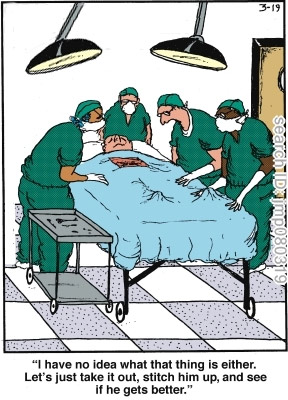
When "heuristic" becomes an uneducated guess.. (www.cartoonstock.co)
The Autonomic Nervous System and Yogic sciences
The autonomic nervous system (ANS) has a sympathetic and a parasympathetic
effect or function. The nerve systems are also physiologically separated.
By rule of thumb, the sympathetic function prepares the body for active
engagement, whereas the parasympathetic function lets the body focus on
its inner processes. This is not in all cases equivalent to "excitory"
vs. "inhibitory". For example, ..
In advanced intuitional (Yogic) experience, the function of the ANS is
effectively to mediate between the Central Nervous System (CNS) and the
expressive phases of the Causal Matrix (referred to as "Ida"
and "Pingala", viewed as subtle channels located in or near
the spine). In other words, the sympathetic and parasympathetic nerve
systems are not the same as the resp. subtle Yogic channels.
Physiologically, the ANS connects all glands and internal organs to the
CNS through its sympathetic and parasympathetic nerves. The sympathetic
nerves emerge from the spinal cord. Most parasympathetic nerves are cranial,
such as the vagus nerve (to the neck, breast and abdominal glands and
organs including the heart), and some are spinal (pelvic nerves). The
primary function of the CNS is to synchronize the sensory and motor organs
and emotions related to glandular secretions, resulting in coherent individual
experience. At the glandular side, this takes the form of "chakra's",
the subtle plexi of Yoga-psychology. A chakra is spontaneously, intuitionally
perceived, usually as a flower-like shape. At the sensory side, i.e. in
the brain, synchronization manifests as the conscious perception of a
consistent world we live in. So, although a chakra is not a literal physiological
shape, in terms of location and function it is identifiable.
The ANS relates to the Causal Matrix through the point of origin in the
center of the cakra's or subtle plexi. The center is not located in a
gland or organ, but is associated with the spine. Physiologically, the
center is not detectible as there is no obvious nerve or other correlate.
For example, the Yogic center of the heart chakra lies at a quite specific
location in the spine, but the sympathetic nerves of the ANS leading to
the physiological heart emerge from not less than four distinct locations
in the higher breast section of the spine. This suggests that the locations
of the cakra's along the spine are solely based on subtle Yogic (resp.
Wave Matrix), rather than on physiological principles. In Yogic science,
when the chakra is balanced, i.e. fully synchronized, the generic creational
/ withdrawal channels are also balanced in the corresponding point of
the spine, and the mind moves to a higher stage.
Thus, the center of a chakra has no direct physiological connection to
its glandular aspect. Both aspects are identified through their common
association with one of the elementary factors ("solid", "liquid",
"luminous", "aerial" or "ethereal"). In
Yogic science and practice, at the glandular site of the chakra the specific
energetic or emotional aspects are generally emphasized, whereas in the
spinal center of the chakra the vital or vibrational aspect is emphasized,
referred to as "generic essence". Through the CNS, that is practically,
through individual experience, the glandular aspect of a chakra remains
associated with its subtle center.
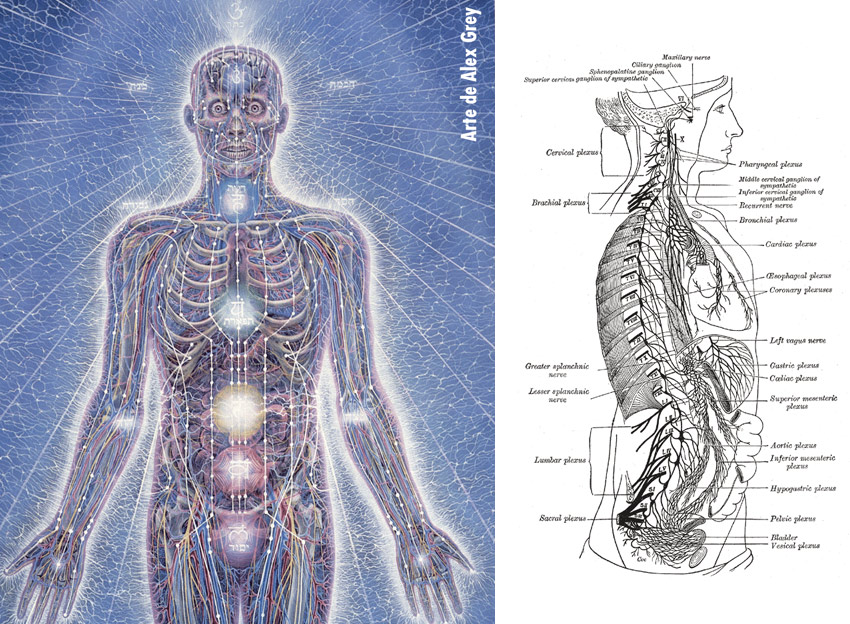
The chakra's or subtle plexi of Yogic (intuitional) science versus
the Autonomic Nervous System: no obvious correlation
(sources: Alex Gray; WikiCommons)
The glands of the brain itself (pituitary resp. pineal) are unrelated
to senso-motor and emotional faculties and hence to the universe of elementary
factors. The encephalic glands have no ANS control and their resp. chakras
have no subtle centers located in the spine. Hence these are purely spiritual
plexi.
Now, whereas the CNS is generally the seat of individual experience, the
ANS, mediating between the purely causal phases of creation (beyond current
scientific understanding) and senso-motor-emotional experience, is practically
the seat of ensoulment. The concept of ensoulment as such does not necessarily
imply fully synchronized experience, i.e. in less developed species. If
the chakra's along with synchronized experience are viewed in terms of
an intrinsic, generic design, the organs and glands, as well as the CNS
fall out of the equation. The result is a generic functional model of
the ANS, and hence a principle of biological ensoulment, independent of
its emergent physiology.
This is the essence of biological design explained in terms of Yogic sciences.
The Anatomy of Heart Coherence - the sympathetic / parasympathetic
(vagus) innervation of the heart as the basis of deep (transpersonal)
psycho-physiology
Anatomically there is a striking difference between locations of the sympathetic
and parasympathetic nerves of the ANS. All sympathetic nerves emerge from
the spinal cord, whereas all parasympathetic nerves are cranial, that
is, emerge from the brain directly, except the pelvic nerves. This hints
at a distinct functional asymmetry, rather than a plain opposition. Generally,
it could be argued that the sympathetic actions are very basic in an existential
sense, whereas parasympathetic actions evolved further along with the
mental faculties. The fact that all parasympathetic nerves except those
of the lower digestive and reproductive systems are cranial (originating
in the lower brainstem) is telling.
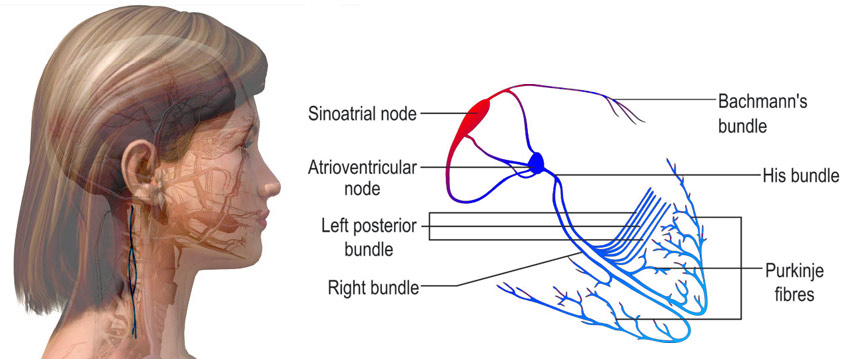
Vagus nerves articulated (blue) and the conduction system of the heart
(adapted resp. from http://www.healthline.com/human-body-maps/;
http://en.wikipedia.org/wiki/Heart)
Whereas the sympathetic nerves innervate the heart uniformly, the parasympathic
or vagus nerve controlling the heart is specialized in that it has itself
two complementary functions. The right vagus controls the sinoatrial (SA)
node, the natural pacemaker of the heart. The left vagus controls the
atrioventricular (AV) node, which regulates the electrical conductivity
of the heart. This parasympathetic differentiation with respect to the
heart is the physiological foundation of heart-coherence, and consequently
of heart-brain coherence.
The traditional explanation of the vagus control of the AV node, "preventing
disorder", namely AV arrhythmia or circular excitations, is somewhat
unsatisfactory. It is inefficient and hence illogical that an imperfect
organ evolves only to be compensated by another. Moreover, the heart has
already a built-in mechanism to avoid too irregular modes.
The vagus AV control is more efficiently explained in terms of Yogic resp.
Wave Matrix pyscho-phsyiology. The heart's function is viewed as the emergent
effect of what essentially evolved as a complex biological oscillator.
The ECG signal biologically represents a far more generic level of wave
synthesis. The sympathetic action, essentially having a physiological
purpose, excites the oscillator, however in an uncontrolled way. The dual
vagus actions, having a basic or more evolved mental origin, work on the
oscillator as filters. The vagus SA action brings up the rhythmic aspect,
whereas the vagus AV action brings up the harmonic aspect. This way the
sumtotal ECG wave is controlled via the sympathetic and parasympathetic
nerves, making the heart a bi-stable complex psycho-physiological oscillator,
or the Autonomic Heart Matrix
|
ANS
|
Left
parasympathetic
(AV); strong |
Left
parasympathetic
(AV); normal |
parasympathetic;
weak |
Right
parasympathetic
(SA); normal |
Right
parasympathetic
(SA); strong |
|
Sympathetic,
weak |
Subjective psycho-physiology - (higher) mental faculties | ||||
|
<< Low HRV
(fixed mood) |
Total
indifference;
(withdrawal, coma, death..) Indifference
|
Bradycardia
(slow rhythm) >>
(random mood) |
|||
|
Sympathetic,
normal |
Stress
High stress (random HRV and random emotions) |
|
COGNITVE |
Isolation
Strong isolation (fixed rhythm and fixed perceptions) |
|
|
Sympathetic,
strong |
Chance
of arrhythmia >>_____<<
Chance of tachycardia
(creation of uncontrolled complex oscillation, no coherent experience) |
||||
| Objective psycho-physiology - homeostasis | |||||
Discussion
Understanding the heart as a bi-stable, autonomic controlled oscillator
redefines the sympathetic as well as the parasympathetic (vagus) actions.
Specifically, whereas vagus action is normally explained as "inhibitory",
from a subjective viewpoint it is in a way "excitory", as it
pulls the mind out of chaos into higher states. Thus the dual parasympathetic
actions provide two paths out of chaos, one through synergetic / empathic
synthesis, the other through individual / cognitive synthesis. These actions
are referred to as the internal synthesis phases of the heart matrix.
Excessive vagus action however pulls the heart out of equilibrium, and
the mind gets either stuck in uncontrolled emotions, or emotional detachment.
In bi-stable equilibrium, the subjective states can effortlessly turn
into their objective counterparts, depending on the autonomic state. Psychologically,
the stronger the general individual focus (self-awareness) is, the greater
the potential and scope for emotional engagement. At the same time, a
blissful condition (harmonic mood) sparks new individual incentives. These
more or less automatic, conceptual transformations are referred to as
the internal reduction or projective phases of the heart matrix.
The parasympathetic differentiation
sets up a basic observer / observed differentiation, although with respect
to the heart alone this obviously does not imply individual perception
in the true sense. Heart-perception is mostly the feeling of individual
identity, which is however psychologically crucial. Heart coherence requires
that "identity" is not same as, or defined only by individuality,
rather it is individuality plus synergy or empathy. Without social synergy,
there can be no social identity, and hence no identity whatsoever.
The sympathetic action on the heart is not perceptual, but rather conceptual
in the sense of "conceiving" or generic creation or genesis.
Without sympathetic action the heart would fall still, if not literally,
then certainly psychologically. However, if there would be sympathetic
action only, the heart's dynamism would primarily serve basic functions
along the line of the fight / flight response. As the sympathetic control
is evolutionary very basic, it constitutes physiological rather than a
psycho-physiological action. At the same time it could be argued that
the parasympathetic control mechanism located in the brainstem forms the
scaffold on which more complex psychology evolves.
The lower digestive and reproductive functions, controlled by the pelvic
parasympathic nerve, are typically mostly instinctive. Other internal
functions can to some extend be brought under control. This is Yogic practice.
The organs in neck and head are also controlled by cranial nerves but
this is not considered parasympathic, except for certain basic aspects
of vocalization, through the vagus.
Understanding and intuiting the psycho-physiology of sympathetic and parasympathetic
action gives deep insight in, and access to the primary, transpersonal
(supramental) empowering and healing states of life and the mind. This
itself is the true meaning of heart coherence. Heart coherence diagnosis
and training is different from traditional Yogic practice, in that it
is not aimed at withdrawal, but at active participation, empathically
as well as individually. Heart coherence requires a healthy amount of
individuality along with the readiness to share oneself with others and
the universe. Only this activates the heart to its fullest potential.
In all cases, sympathetic and parasympathetic action should be balanced,
that is, not too weak and not excessive. This way, the physiological and
psychological bi-stable wave matrix of life can manifest itself, so that
the transpersonal - and therefore inexhaustible - resources can be utilized
to the fullest.
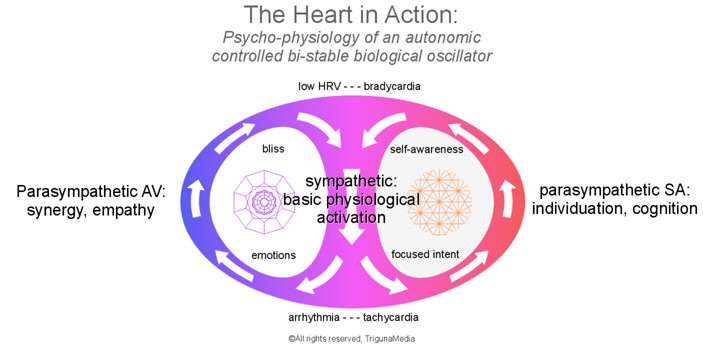
The physiological Heart Matrix
The Heart's Mystical Connection
The Universal Matrix of creation and experience essentialy refers to transpersonal
states and is for that reason somewhat idealized. In other words, it is
fundamentally not a micro-cosmic, but a macrocosmic approach. Mysticism
is the "search of the little for the Great" [Sarkar]. To understand
and work with advanced heart and brain coherence, we should start from
the point where we are - that is, the microcosm. In truth, the microcosmic
frame is "hidden in plain sight" in the universal wave matrix
of the heart / brain constellation. The sympathetic action creates a conceptual
arrow (bio-genesis), in the sense that it transforms subjectivity into
objectivity. At the same time, the dual parasympathetc actions create
a basic "observer-observed" differentiation, that, is, the perceptual
arrow. This way, the sympathetic and parasympathetic actions combine to
form the matrix of individual experience, that is, through the combined
conceptual and perceptual bifurcations. Hence, the universal matrix and
the individual matrix together form the universal matrix of Creation and
Experience. In below figure (from a presentation on mysticism) the lemniscate
cycle also refers to the autonomic matrix of the heart:
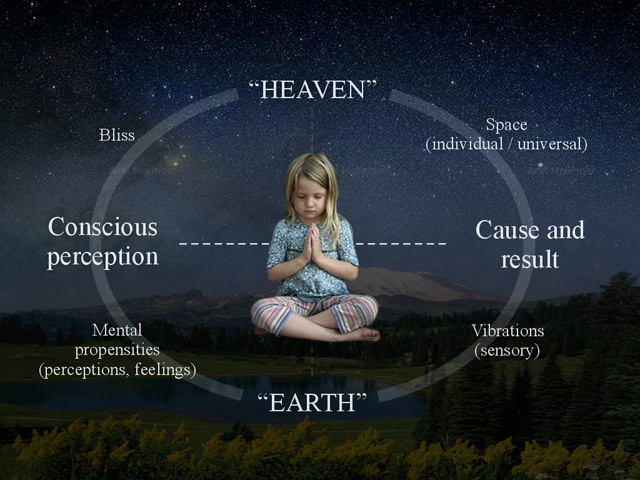
The individual (microcosmic) matrix combines a conceptual (subjectivity,
"Heaven" - objectivity,
"Earth") and a perceptual (cause/result, "Observer"
- conscious perception, "Observed")
orientation and is embedded within the Universal (Macrocosmic) Matrix
of the transpersonal
faculties.
powerpoint & annotations: http://science.trigunamedia.com/mk2011/
Mapping Heart - Brain Coherence: from identity to personality
The mind, in order to exist must have a physical basis. Heart coherence
constitutes the heart's or entitive level of subjectivity, and the heart's
existential sympathetic state is its object. Similarly, brain coherence
constitutes the personal level of subjectivity, while the entitive heart
matrix is its object. In other words, identity may exist without personality
(personal subjectivity), but personality cannot exist without identity.
This touches the deepest principles of practical psycho-physiology, as
it means that the brain alone cannot be considered the basis of the mind.
For the sake of argument, an adult receiving an artificial heart may not
quite loose his or her personality overnight. But if a newborn would be
fitted with an artificial heart, it is easily felt that it would not likely
develop a normal personality at all. Therefore, in a more or less direct
sense, the heart-brain constellation is the physical basis of the mind,
and indirectly, the whole body is. Heart-brain coherence effectively constitutes
the complete wave matrix of practical psycho-physiology.
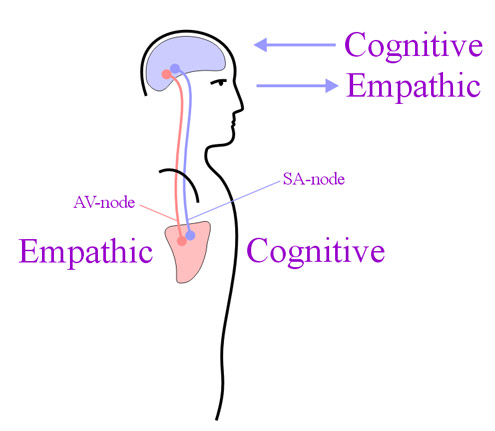
EPECA - Science & Sprituality - (available as .pdf)
It could be argued that, while
for example the right vagus controls de heart's individuation and cognition,
logically the right hemisphere equally controls the same on the personal
level. However this is only true for the objective aspect of the brain,
from where the parasympathic nerves emerge, whereas the given psychological
correlates are purely subjective. Evidently, the brain's internal projective
phases follow the same path as those of the heart. That is, subjective
synergetic reduces into objective individual, and vice versa. That is
why the left hemisphere is commonly thought of as being "cold logical",
whereas it controls the left vagus or synergetic action on the heart.
Likewise, the right hemisphere is though of as being empathic, imaginative
and creative, whereas it controls the right vagus or cognitive action
on the heart. This should however not be taken too romantically, rather
it indicates that the dual matrix states may be somewhat lateralized.
In brain coherence diagnosis both subjective states are generally found
to be spread over both hemispheres.
In actual heart-brain coherence diagnosis and training there is no direct
concern about the different internal heart - ANS - brain process flows.
But it is essential to understand and memorize the resultant dual heart-brain
reduction- / mental-projective resp. synthesis / bio-integrative phases.
This "matrix of the mind" maps and unites the allover subjective
and objective states of wave matrix psycho-physiology, that is, the four
transpersonal empowering and healing states of creation and experience.
The dual objective transpersonal states are measured through the ECG (heart),
while the dual subjective states are measured through the EEG (brain).
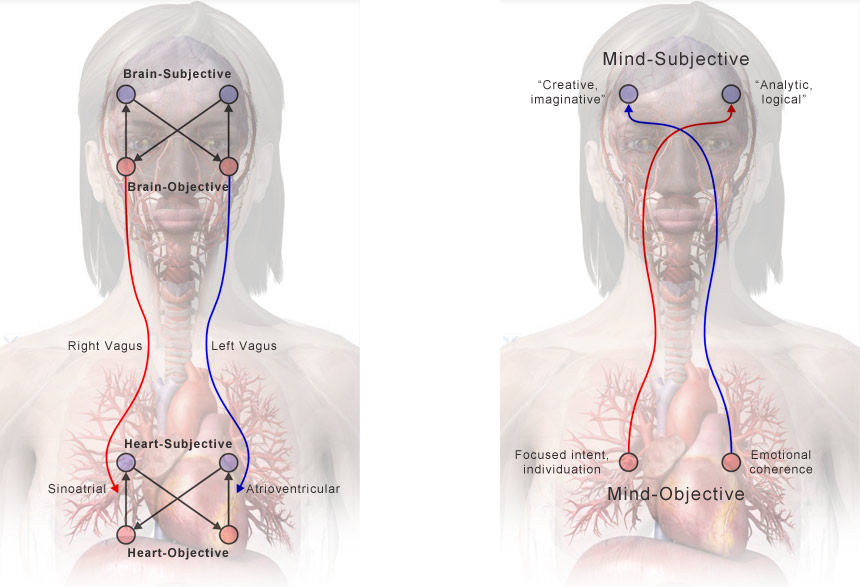
Heart-brain coherence is alround mental coherence. The heart's identity
is the objective basis of the brain's personality. In the
"mind" diagram, the arrows indicate the physiological integration
phases, not to confuse with the normally crossing reduction phases.
The subjective states are loosely recognized, however essentially indicate
somewhat lateralized transpersonal states.
(background adapted from http://www.healthline.com/human-body-maps/).
Note that also the objective states are referred to as "transpersonal". This may seem uncommon in terms of Yogic practice as usually the focus is supreme subjectivity. However, to stay with the Yogic line of thinking, Supreme Consciousness is not only "subjective", it includes all four transpersonal states, and is in this context referred to as Universal Entity (Sarkar). This shows from a slightly different angle, that wave matrix physics is aimed at participation, while traditional Yogic practice is typically oriented on withdrawal.
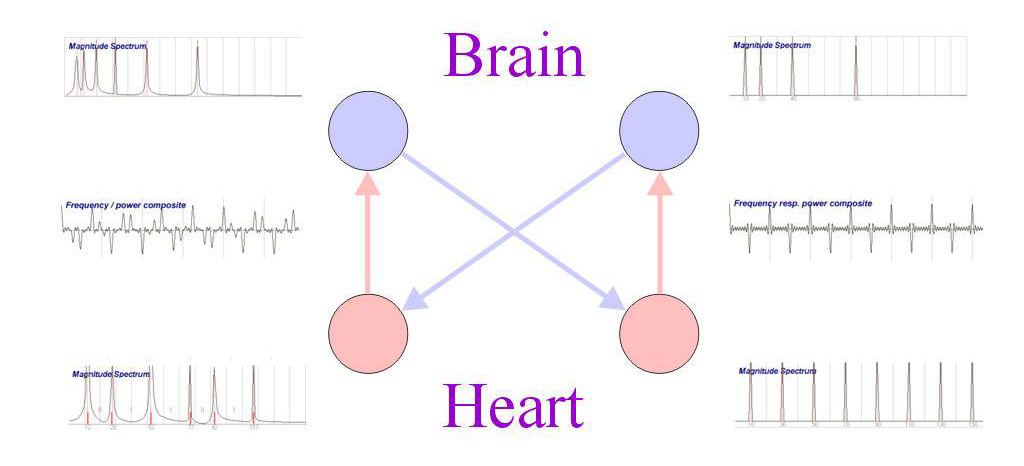
Numerical analysis of ideal coherent ECG and EEG patterns - http://science.trigunamedia.com/fractalsynth.
EPECA - Science & Sprituality - (available as .pdf).
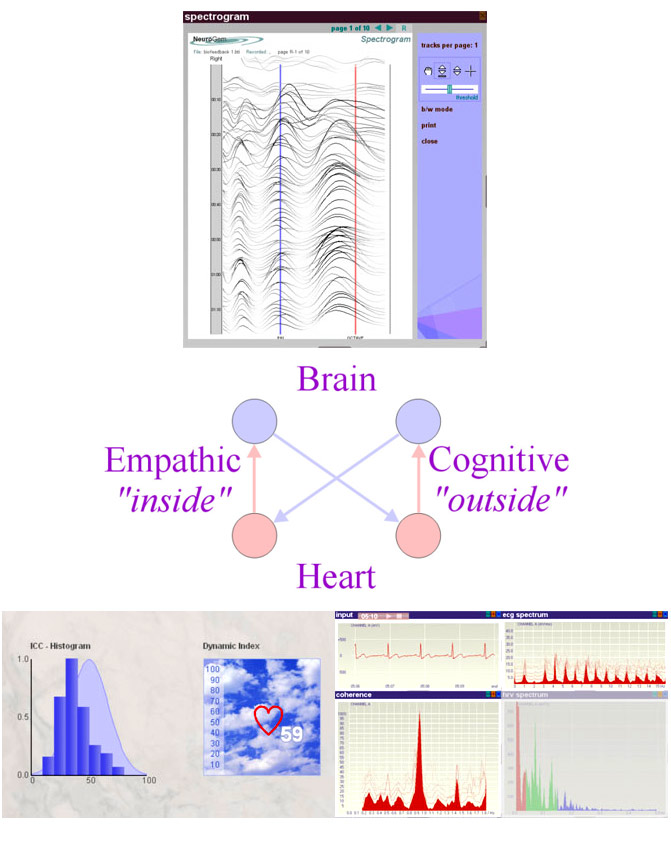
Measuring the Matrix: Cardiogem + NeuroGem full Heart & Brain diagnosis
+ biofeedback
www.trigunamedia.com
Into the heart of
Yogic sciences
The heart-brain constellation is practically the physical and physiological
basis of the mind. The mind controls the glands, senses and organs and
is itself as a whole controlled by the Causal Matrix. Every gland and
internal organ has its own primitive matrix, as described in more detail
for the heart and brain. In each matrix, the genesis phase is controlled
through the sympathetic actions of the ANS, and the synthesis phase or
phases are controlled through parasympathetic action. In the heart, the
implicit differentiation of the parasympathetic action becomes evident,
and in the brain it can be quite explicit. In other glands and organs,
the parasympathetic differentiation is less apparent.
Now, the universal and the Yogic viewpoints on how the mind relates to
the Causal Matrix are somewhat different. Physiologically, that is, in
terms of sympathetic and parasympathetic action there is no fundamental
difference. This is the basis of the mind. But if the fundamental expression
is considered, there is a crucial difference. From a universal stance,
expression happens through the dual reduction or mental projective phases,
that is, the transformations from the subjective into the objective transpersonal
states. In Yogic philosophy, all mental expressions are perceived in terms
of a fundamental relation between cosmic and unit, and vice versa. It
is a rather personal approach, lacking ultimate conceptuality. This is
why in Yogic perception, one of the causal channels is perceived as "male
or "heating" (cognitive controller - FB), whereas the other
is "female" or "cooling" (generic receptacle - FB).
In the transpersonal creation matrix, the channels, that is the dual reduction
phases are also complementary but not opposite. The Yogic channels do
not relate objectivity with subjectivity, rather, objectivity and subjectivity
are not well defined in Yogic philosophy. Therefore, Yogic philosophy
cannot ultimately explain creation, as it is essentially a dualistic approach.
The Yogi progresses through subsequent stages which he interprets as the
direct effect of balanced mental propensities on the sympathetic or genesis
channel. He may not actually realize that this effect is purely associative.
In truth, his mind is balanced through the parasympathic actions, and
this in turn relates to the sympathetic action via the brain. In other
words, while in Yogic terms, the balancing of a chakra results in passing
through a centre in the spinal cord, there is no direct physiological
or even subtle connection between the two. Ultimate realization however
lies not in passing these centers as such, but in the sum total psycho-physiological
state anticipating it. This is the reason why according to Yogic wisdom
one cannot achieve final liberation through one's own will and discipline,
only through surrender and grace, as ultimately the aspiring mind is the
result, not the cause.
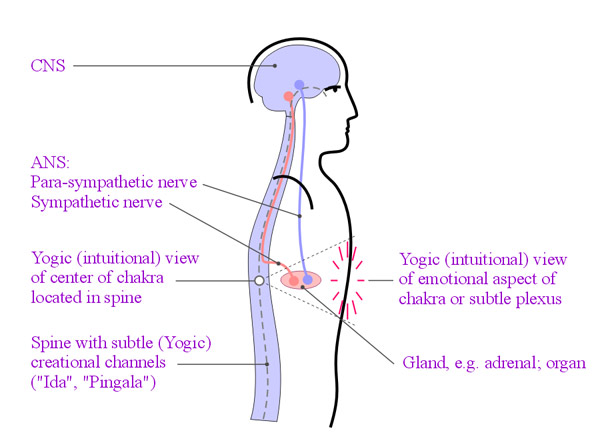
The Yogi connect a chakra with its center in the spinal cord, by association
EPECA - Science & Spirituality - (available as .pdf)
Below figure shows the combined physiological and Causal Matrix. Clearly, the sympathetic and parasympathetic actions have direct physiological correlates, but the actual mental expressions, i.e. the dual reduction or projective phases, have not. The reduction phases are spiraling only to articulate the corresponding Yogic centers in the spinal cord - this is not necessarily accurate.
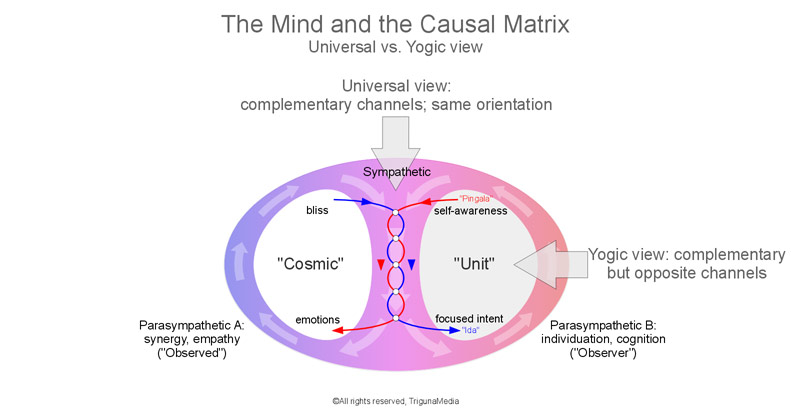
The physiological and Causal Matrix together
Biogenesis & Cosmology - the dual path out of chaos
The science of "emergence" or "emergent behavior"
describes the spontaneous creation of order out of chaos. Emergent bahavior
of complex systems (i.e. matter, or rather, the combined and mixed material
phases) is often proposed as the ultimate explanation of life, but it
was never proven. The concept of "emergence" is expanded with
the concept of Causal Matrix as a more comprehensive approach to biological
design or bio-genesis. Below figure briefly captures the principal stages
of bio-genesis with an intrinsic causal component:
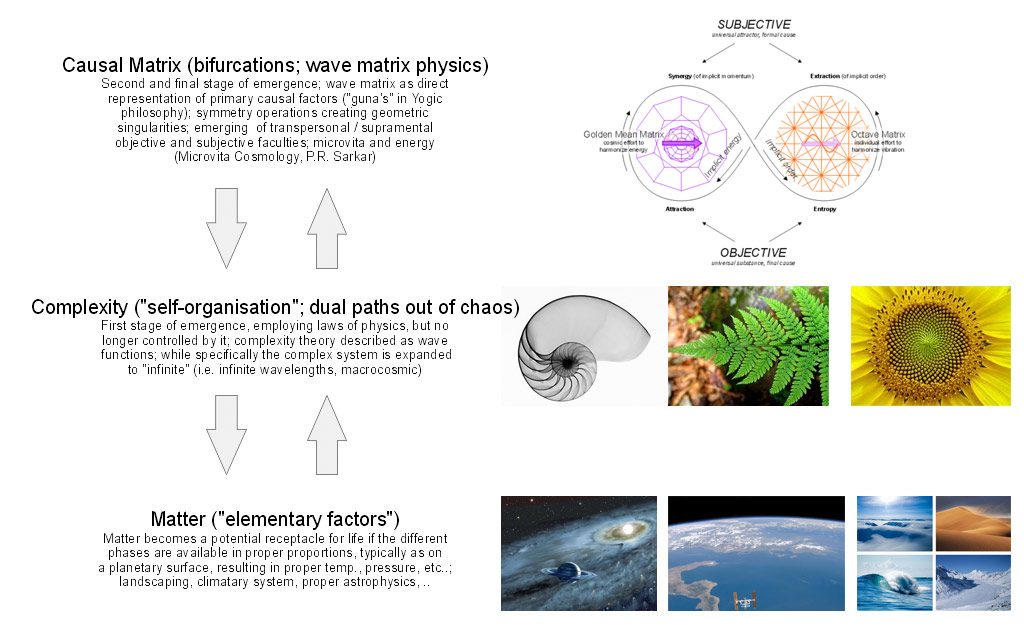
Meditation types in wave matrix psycho-physiology
Excerpt, Neuro-physiological correlates of higher states of consciousness
in the context of universal empiricism (Frank van den Bovenkamp; awaiting
peer-review)
Originally two different types of meditation (a technique to create higher
states of consciousness) were proposed by Lutz (Lutz, Dunne & Davidson,
2008), namely "focused attention" and "open monitoring".
Later, a third type was proposed, "auto-transcendence" (Travis
and Shear, 2010). The latter emerged from the technique of Transcendental
Meditation (TM). The term "transcendence" specifically refers
to a proposed non-dual state, where the subject / object dichotomy has
dissolved. The process to get there or "inward stroke" in TM
vocabulary could be referred to as "transcending". With respect
to universal empiricism, there is theoretical scope for two types of transcending,
resp. transcendence. One is on the "outside" resp. observer
side, that is, from "Objective A to Subjective B". This could
be referred to as "cognitive transcendence", resulting in pure
(self-) awareness. The other is on the "inside" resp. observed
side, that is, from "Objective B to Subjective A". This could
be referred to as "empathic transcendence", essentially resulting
in pure bliss resp. devotion.
Reported experiences during TM transcendence include "Absence of
time, space, body sense (68%), peaceful (32%), unbounded (20%)" (Travis
and Pearson, 2000). Experiences like "bliss", "compassion"
or "devotion" are not typically mentioned. This is one of the
reasons suggesting that TM is essentially a technique of cognitive transcendence.
Other types of meditation are more empathic or devotional in nature. The
result of that type of meditation is categorically reported as a "blissful
state". An example of this type is Ananda Marga (AM) meditation (
"Ananda" means bliss, and "marga" is path). The AM
technique has some aspects in common with TM, specifically the use of
mantra, but more importantly, it is equally aimed at auto-transcendence.
However in the case of AM technique it is empathic or devotional auto-transcendence.
Josipovic was keen to observe that "the non-referentiality of compassion
makes it more akin to meditations in the non-dual or ‘automatic self-transcending’
category", that is, rather than a focused attention type as suggested
by Travis and Shear (Josipovic, 2010). In any case, compassion is far
more akin to empathy than to cognition. In case of doubt regarding this
differentiation, "devotion" is definitely not aimed at or felt
during TM, whereas in AM meditation devotion is essentially the goal and
reason. So this introduces a fourth type of meditation, summarizing:
- Focused attention (example: Tibetan Buddhist loving-kindness-compassion)
- Open monitoring (example: Buddhist Vipassana)
- Cognitive auto-transcendence (example: Transcendental Meditation)
- Empathic auto-transcendence (example: Ananda Marga)
(Travis and Shear, 2010, except
"empathic"..)

Note: "Focused attention" is not necessarily the same as pure
objective focus - meditating on crude objects is not desirable. Hence,
all arrows are emphasized, suggesting that the mind gets integrated and
balanced. An example of focused attention is deity meditation (Kozhevnikov,
Louchakova, Josipovic & Motes, 2009), where the meditator associates
oneself with certain visible or subtle qualities of deities, with the
idea that one can actually acquire those qualities (for example, courage,
compassion, etc..). Another example including focused attention is TM-Sidhi
practice, combining focus on a sutra (phrase) with transcendence (Travis,
2011). On the contrary, either type of auto-transcendence is positively
aimed at making the mind subtler in an otherwise unspecific way. The proposed
differentiation between cognitive and empathic auto-transcendence is not
only represented in the universal empirical matrix but also refers to
cognitive versus affective- or social neuroscience. Open monitoring is
not aimed at and concerned with any contents at all. For the sake of argument,
a fifth type of "meditation" could be added, which implies focus
on relatively crude objects and objectives - this is generally the case
in everyday life and for non-meditators. Either way, the principle is
"as you think so you become" - hence the goal of all types of
meditation is to expand the mind conform human potential.

Josipovic, Z. (2010). Duality
and nonduality in meditation research. Elsevier Journal for Consciousness
and Cognition, 2010, www.elsevier.com/locate/concog.
Kozhevnikov, M., Louchakova, O., Josipovic, Z. & Motes, M.A. (2009).
The enhancement of visuospatial processing efficiency through Buddhist
deity meditation. Journal of the Association of Psychological Sciences,
2009.
Lutz, A., Slagter, H. A., Dunne, J. D., & Davidson, R. J. (2008). Attention
regulation and monitoring in meditation. Trends in Cognitive Sciences,
12(4), 163–169.
Travis, F. (2011).. Comparison of coherence, amplitude, and eLORETA
patterns during transcendental meditation and TM-Sidhi practice. International
Journal of Psychophysiology, (in press)
Travis, F., Pearson, C. (2000). Pure Consciousness: distinct phenomenological
and physiological correlates of "consciousness itself". International
Journal for Neuroscience, 2000, Vol. 100, 77-98
Travis, F., Shear, C. (2010). Focused attention, open monitoring
and automatic self-transcending: Categories to organize meditations from
Vedic, Buddhist and Chinese traditions. Elsevier Journal for Consciousness
and Cognition, 2010, www.elsevier.com/locate/concog.
Shrii P.R. Sarkar - Microvita and Cosmology
The concept a universal matrix of creation and experience, is not found
in classical philosophy. There is similarity with "phenomenalism",
especially the epistemological variety (Berkely) in the sense of discrimination
between a noumenal and phenomenal cause, but in phenomenalism both causes
are not fully evolved, let alone reconciled. However, universal empiricism
is virtually interchangeable with a contemporary, paradigm shifting cosmological
theory from the Indian philosopher and social revolutionary Shrii P.R.
Sarkar. Sarkar introduces his theory from a bio-psychological, rather
than a philosophical angle. As the proposed model is deeply inspired by
Sarkar's theory, the latter is briefly clarified here.
Sarkar: "Although this is not an easy subject, we should study the
impact of the inferences on the mental propensities [etc..]" (Sarkar,
1989). "Inferences" refers to sensory- and possibly other waves
or information influencing the biological body and mind. This, in a rather
inconspicuous way, already hints at a universal basis of the mind, because
"impact" refers to direct influence and control by environmental
factors, rather than an independent individual processing sensory input.
Further, "This is a new line of thinking, a new philosophical approach.
Here, 'knower I' or 'doer I' are not necessarily the 'mahat', 'aham' or
'citta' [resp. mental stages] of philosophy.. New Sanskrit terms will
have to be created:
- Knower-I is Jina Purusa [Knowing Principle]
- Doer-I is Krta Purusa [Actional Principle]
- other.." (Sarkar, 1989)
|
SUBJECTIVE A Doing principle or supra mundane seed of the actional principle, ready for being sprouted (microvita of different characters, either of positive or negative nature, collectively maintaining the balance of the actional universe, creating initial forms of carbon [carbonic? - ed.] atoms that help macro- and micro propensities in having their purely physical [i.e. material -ed.] auxiliary media with mass and wants) |
SUBJECTIVE B Knowing principle or supra-mundane knowledge (expressed energies of different characters; indestructible, interchangeable and inter-transmutable) |
|
OBJECTIVE B Planes of microcosmic and macrocosmic propensities (different strata of mind: conscious, sub-conscious, physico-psychic, psycho-physical, and psycho-spiritual [controlled by Subjective A - ed.]) |
OBJECTIVE A Planes of universal macrocosmic inferences and their reflected and refracted inferences (planes of inferences which are being activated, accelerated and stimulated by Subjective B) |
Table 1 - Creative principles and their interactions in Microvita Cosmology (Sarkar, 1989)
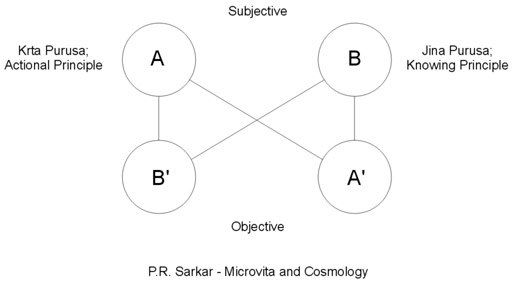
Sarkar, P.R. (1989). Microvita
and Cosmology (lecture). Microvita in a Nutshell, Ananda Marga Publications,
3rd. edition, 153-158
EPECA - European Psycho-energetic Coaching Association
- presentation + workshop "Science & Spirituality"
- Photo's Nov. 2011 (presentation in Dutch only).. - www.epeca.eu; www.frankvandenbovenkamp.com

Venue "De
Kluizerij", Affligem, Belgium
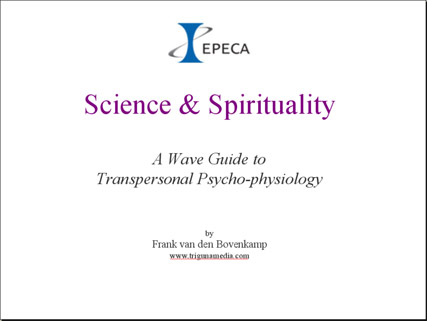
Powerpoint available as .pdf here
(powerpoint: open with right-click- "show";
allow dynamic content; slides with java animations continue by clicking
outside slide)
More photo's here

Biological Grand
Design: Wave Matrix Physics in BioArchitecture
"The Art and Science of building spaces which create, support
and enhance life and living systems" - MR.
http://www.bioarchitecture.ie
Michael Rice -
Bioarchitect (Ireland)
Michael is an award winning bioarchitect and a pioneer in the field of
bioarchitecture. He studied at the School of Architecture in University
College Dublin and established his own practice in 1998 based in the heartland
of Ireland, specializing in bioarchitecture, the universal geometry of
creation, natural design and sustainable living. He has designed over
400 buildings based on these harmonic principles, from meditation huts,
to homes and community spaces of every shape and form. His knowledge of
the Science of Creation offers deep insight into how the shapes of our
dreams, thoughts and emotions create our worlds.

TrigunaMedia (Frank) advises Michael on using the principles and vocabulary
of Causal Matrix, Microvita Cosmology and Wave Matrix Physics to integrate
his deep natural intuition and rich toolset into a singular, coherent
and hence powerful approach. This helps Michael to share his vision and
practical ideas on sustainable design with clients, colleagues and community
in a scientifically sound way, while at the same time fully engaging the
subtler qualities needed for creating unique, living spaces.
Michael and Frank co-authored a brochure outlining the extensive scope
of the Bioarchitecture services, design process and project flow, which
can be downloaded here.
Another recent great reading article from Michael is "The
Science of Seeing", exploring contemporary research of the brain's
response to visual stimuli, including neuro-esthetics and measurable sensitivity
to topological features, large spaces etc. Michael shows that many studies
as well as cultural practices point at a common attraction to self-similarity
(fractality or other geometry) in nature as well as in man-made structures,
which may be traced back to fundamental neurological process. This chemically
activates the brain's own bliss-making mechanism. These insights are used
to design spaces which on a deep level promote a sense of well-being,
and therefore support life and living systems - in other words, bioarchitecture.
Discussion: could it be that "external" geometric stimuli
activating the brain's (chemical) bliss-making process, in fact resonate
with an intrinsic geometry of perception itself - meaning that "bliss"
is just a word for the deep connectedness we feel when "external"
and "internal" creation (or: design..) turn out to be one and
the same thing? Which, in turn, may explain the isolation we feel for
example when architecture (dreary office buildings, hospitals, etc..)
is utterly disconnected from the pure principles of natural creation?
Compare with evidence of geometry of color perception, here.
Further evidence of wave matrix physics in psycho-physiology

-
IF YOU REPLY TO THIS NEWSLETTER PLEASE DO NOT RETURN THE WHOLE CONTENT
- CLICK
HERE TO REPLY
-
© All
rights reserved, TrigunaMedia, 2011